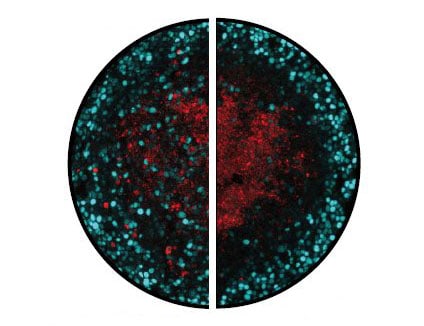
Physicists in France have found that the simple application of mechanical pressure can slow down the growth of a tumour and limit its size. The researchers, who carried out their work using mice cells, say the results could lead to better diagnostic tools for cancer and perhaps eventually to new kinds of drugs to treat the disease.
It is well known that tumours form and develop into cancers when the DNA inside living cells mutates, but how that development is influenced by the environment around a tumour remains a subject of debate. The new research, by Jean-François Joanny of the Curie Institute in Paris and colleagues, investigates how a tumour’s growth is limited by the pressure it experiences as it pushes against the surrounding healthy tissue.
It is difficult to separate out the roles of genetics, biochemistry and mechanics in a tumour within a living organism. To get around this problem Joanny’s team does its work on the laboratory bench using a tumour-like ball of mouse cells with a diameter of a few tenths of a millimetre. The researchers place the simulated tumour into a bag several millimetres long and made from a semi-permeable polymer. This is then put into a solution containing nutrients that allow the cells to grow. Left alone in this state the tumour would have continued to grow for two to three weeks, until it reached a steady-state in which cell death exactly balances cell division.
Clamping down with sugar
To find out what effect pressure has on this growth, the team adds long sugar molecules to the solution. These molecules are too large to pass through the tiny pores in the bag and so remain outside the bag, creating an imbalance in their concentration that forces solution out of the bag in order to try and restore equilibrium. The greater concentration of solute outside the bag then exerts mechanical pressure onto the bag, and this pressure is felt by the tumour inside. This is repeated using identically prepared tumours, each one in its own bag and immersed in a solution with a different concentration of sugar, therefore exposing each tumour to a different pressure.
The team found that the higher the pressure the slower the tumour growth and the smaller the tumour’s ultimate size. For example, exerting a pressure of 500 pascals (just 0.5% of atmospheric pressure), halved both the growth rate of the tumour and its steady-state volume.
To establish exactly how pressure slows growth, Joanny and co-workers froze the tumours, cut them into very thin slices and covered the slices with two kinds of antibody. This reveals the distribution of dying and dividing cells in each tumour – the two kinds of cell fluorescing at a different wavelength. They discovered, contrary to expectations, that applying pressure to a tumour does not appreciably change the rate of cell death. Instead, pressure only appears to affect cell division, reducing it throughout the tumour, but especially in the core.
No room for division
Comparing these results with a computer simulation, the researchers concluded that this slower growth results directly from the mechanical pressure, rather than any biochemical processes affected by the change in pressure. The simulation represents pairs of cells as mutually repelling particles, each of which divides into a new pair when their separation exceeds a certain value. With cell death represented by a constant rate of particle removal, increasing the pressure on the outside of the simulated tumour yields a reduction in growth that matches that observed in the experiments.
Having found that placing a tumour under pressure reduces the final size of that tumour, team member Fabien Montel points out that the most invasive, and therefore most dangerous, tumours ought to be those that are able to withstand higher pressures. He says he and his colleagues would like to be able to prove this correlation by placing tiny biosensors onto tumours inside patients and establishing that the most dangerous ones are indeed those subject to higher pressures (he adds that these sensors could ultimately be used as a diagnostic tool to gauge how dangerous individual tumours are). But he says this would be extremely difficult to do with current technology and so a more achievable next step would be to take pieces from tumours that have been removed from patients and expose them to the laboratory stress test, so demonstrating, albeit within idealized conditions, that the pressure–invasiveness correlation is real.
“We are not saying that mechanics is the only way of looking at tumour growth because we know there is a lot of biochemistry involved,” says Montel. “But maybe we don’t have to know all the details of what is going on inside the cell in order to understand its growth.”
The research is described in Phys. Rev. Lett. 107 188102.



